Reviews
George Marshall
USA, 1939
Credits
Review by Evan Kindley
Posted on 29 July 2009
Source Universal DVD
Categories Women of the West
George Marshall’s Destry Rides Again opens with an image of a sign reading “WELCOME TO BOTTLENECK.” We then track past a roiling chaos of cowpokes punching and shooting each other and falling off horses, generally setting the movie’s testosterone level to “over the top.” True to its name, Bottleneck is a system at a standstill, a collection of forces crammed within a limited space, each trying to dominate and overcome the others.
Things are not much calmer inside the Last Chance Saloon, where the men stop fighting only long enough to cheat each other at cards, which inevitably leads to more fights. In this overwhelmingly male, and rather rowdy, environment, the dominant figure is nevertheless a woman. Frenchy — played by the distinctly un-French Marlene Dietrich — is star performer at the Last Chance Saloon, paramour of bad guy Kent, but universally acknowledged “real boss” of Bottleneck. We first discover Frenchy amidst a crowd of cowboys (where she’ll spend most of the picture) lasciviously applying saliva to her homemade cigarette, before joining the boys on a chorus of “Little Joe.” She’s the only woman in the saloon, but she rules over it absolutely, and it’s fascinating to watch Dietrich so completely in control of her environment (and the filmmakers use a combination of high and low angles to point up Dietrich’s mastery over the space, particularly when she’s on stage). Her performance here, which revitalized her career, is a star turn for sure, putting her European femme fatale skill set to work in that most American of genres, the Western. What must have sounded like a strange idea at the time in fact plays to Dietrich’s strengths, allowing her to assert her toughness, her playfulness, her androgyny, and her outsize sexuality by turns.
It’s interesting, for instance, to note the difference between Dietrich’s body language on-stage and off. In the crowd, she’s loose and slinky, pushing herself into the crevices between cowboys, using her feather boa and legs alike like spider webs to ensnare her prey. On stage, on the other hand, she adopts her trademark ramrod-straight posture, playing up her aloof androgyny and Teutonic chilliness. (Which is not to say she isn’t sexy: on the contrary, her performances are the kind that make men spurt decks of playing cards and fire pistols in the air.)
The larger dynamic of the film emerges out of the contrast of these early scenes, which conjure the wild milieu of the saloon and establish Frenchy’s power over it, and the more understated charm of Jimmy Stewart, who enters the picture about twenty minutes in and redirects its energies completely. Stewart plays Tom Destry, son of a famed lawman who cleaned up Tombstone, who is summoned by Bottleneck’s new sheriff (and former town drunk) to be his new deputy. He’s first seen in town holding a parasol and birdcage for Miss Tindall (a female fellow stagecoach passenger), and it’s a running joke that Destry is soft, even feminine, in comparison to the town’s typical male inhabitants. Next to the rough and tumble cowboys of Bottleneck, Destry does comes off like a sissy: a city boy with nice manners, an earnest concern for law and order, a hobby of carving napkin rings, and a principled dislike for guns (though he later proves to be pretty handy with one). Stewart uses his gift for gentle comedy to great effect here; as Destry, he walks around looking perpetually amused, and also slightly canted, as if he’s about to fall over. Where Frenchy dominates and insinuates, Destry charms and defers, neatly reversing the stereotypes associated with their respective genders.
The most effective scene of the film plays these two affects off one another, giving equal space to Frenchy’s wildness and Destry’s cool. Destry breaks up a pretty intense catfight between Frenchy and the wife of a man who she’s cheated in poker by dumping a bucket of water on both of them. Frenchy’s response is Dietrich’s most exuberant physical moment, as she starts kicking him, and ultimately ends up hurling glasses at his head while he shields himself with a chair. “Now wait a minute, lady…” Destry begins, only to be interrupted by Frenchy’s defiant shout: “Don’t you call me lady!” In this exchange in particular we see the theme of Destry Rides Again as a whole (along with many another Western): the struggle to bring a new social order, a sense of law and ethics, to the wild frontier, is here linked to the attempt to turn Frenchy into a “lady,” a civilizing process she resists all the way.
Destry Rides Again is somewhat strange in that it’s a film with two highly memorable, convincing lead performances that feel as if they belong to different movies. Stewart and Dietrich have a few good scenes together, but in the end they don’t really click, or at least not as well as Dietrich does with the cowboys, or Stewart with his deputies. The interesting thing here is how the taming of the West gets gendered differently, depending on the circumstances: it might be the introduction of Eastern (feminine) refinement in one quarter, or the curbing of undue distaff influence in another. It’s as if the frontier, precisely by being lawless, provided a space for a certain amount of experimentation with gender, thus allowing a woman like Frenchy to have an unusual amount of power. So Destry’s role is both to make Bottleneck a more controlled, orderly, “feminine” place and to end the social anarchy that allows a fallen woman to become the town’s “real boss.”
In the movie’s own terms, what this means is that Stewart begins to wrest the movie away from Dietrich, which is not necessarily a happy development from the perspective of the audience. While we may be contented to follow Stewart into quieter, more even-tempered territory and away from the mayhem of the early scenes, he’s not entirely able to make us forget them, and the resolution of Frenchy’s story is far from satisfactory. Part of the problem is that, having shown us Frenchy as the mistress of the Last Chance Saloon, the story doesn’t find much of a role for her until the penultimate scene (other than a few classic musical numbers, that is).
It may be slightly unfair to judge Destry Rides Again by the standards of the ordinary Western. Often billed a Western “spoof” or “comedy” rather than an entry in the genre proper, it does include a higher than average number of clever lines and exaggerated characters (including an excitable Russian, played by Mischa Auer, who delivers the classic line, “All I want to do is be-a a cowboy and wear my own pants!”). This penchant for comedy branches out in two incompatible directions, however: if the early scenes, centering around Dietrich, point toward the exuberant high spirits of John Ford’s My Darling Clementine (or even Mel Brooks’ Blazing Saddles, whose Lili von Shtupp is modeled on Frenchy), then the offhand charm of Stewart’s scenes anticipated more understated, character-based Westerns like Howard Hawks’ Rio Bravo. (Dietrich herself would have to wait for Fritz Lang’s 1952 Rancho Notorious for a chance to strut her stuff unopposed.)
All of which is to say that Destry Rides Again paved the way for much more successful films, each of which took one or another element of its improbable brew and developed them more thoroughly and satisfyingly. The whole thing might have worked better if the filmmakers had staged a more direct confrontation between Dietrich’s aggressive presence and Stewart’s relaxed urbanity, a sort of extended version of their first scene together in the saloon, with her throwing the glasses and him deflecting them. But rather than let the friction between them play out, screwball-comedy style, the film takes a decidedly wrong turn in a scene where Destry visits Frenchy at home and shames her, not only for the company she keeps but for her cosmetic decisions as well: “I bet you got kind of a lovely face under all that paint. Why don’t you wipe it off some day and have a good look? Figure out how you can live up to it.” Such moralizing doesn’t really fit in either with the anarchic mood of the film’s opening or the gentle humor of the Stewart-dominated scenes, and it also effectively pours cold water all over Dietrich’s performance. Her response to this advice, in fact, is sort of heartbreaking: he leaves, and a chastened Frenchy dutifully removes her lipstick, gazes into her mirror… and is transformed, via a matching shot, into the chaste Miss Tindall — she of the parasol and canary cage.
At this point the film isn’t done yet, and neither is Dietrich, technically: she still gets to sing “See What The Boys In The Back Room Will Have,” the movie’s most famous number, in a memorable getup complete with cowboy hat, riding crop, and bejeweled vest and skirt (one of a few moments in the film that flirts with the iconography of S&M). But apart from this spotlight moment, Frenchy is increasingly relegated to the sidelines, reduced to standing around and wringing her hands as the feud between Destry and Kent escalates. Strangely enough, she plays almost no part in the film’s climax, in which a different kind of femininity takes over. This is a full-scale saloon brawl between Kent’s goons and the rolling-pin-wielding wives of Bottleneck, who beat the errant cowboys down with savagery: a triumph of domesticity over deviltry. A funny enough idea, but in execution it comes off way too broad, unworthy of either the elegant chaos of the early Dietrich scenes or the subtle comedy of the Stewart scenes. Even worse, it’s a rare moment of invention in a basically conventional dénouement, which goes through the motions of the restoration of law and order to Bottleneck in a pretty mechanical fashion. Sadly, the movie as a whole, which began with such potentially intriguing chemistry, pretty much conforms to Destry’s prediction: “I think this ol’ town’s gonna settle into something pretty peaceful one of these days.”
More Women of the West
-
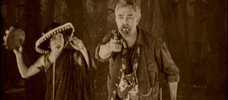
49-17
1917 -
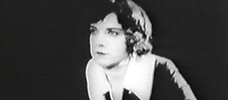
The Gun Woman
1918 -
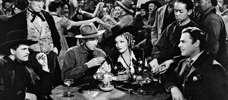
Destry Rides Again
1939 -
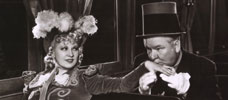
My Little Chickadee
1940 -
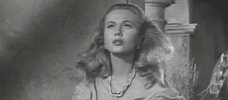
Colorado Territory
1949 -
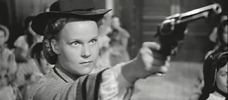
Westward the Women
1951 -
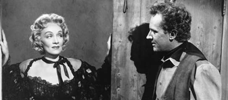
Rancho Notorious
1952 -
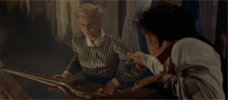
The Violent Men
1955 -
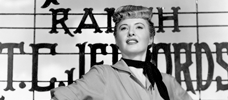
The Furies
1950 -
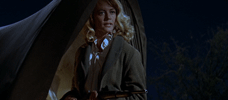
The Last Sunset
1961 -
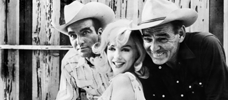
The Misfits
1961 -
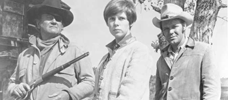
True Grit
1969 -
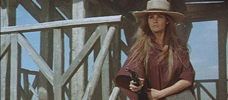
Hannie Caulder
1971 -
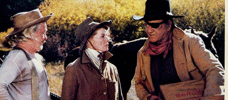
Rooster Cogburn
1975 -
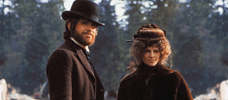
McCabe & Mrs. Miller
1971 -
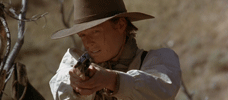
The Ballad of Little Jo
1993 -

The Quick and the Dead
1995 -
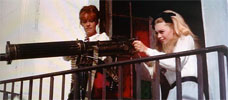
Viva Maria!
1965 -
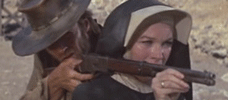
Two Mules for Sister Sara
1970
We don’t do comments anymore, but you may contact us here or find us on Twitter or Facebook.



